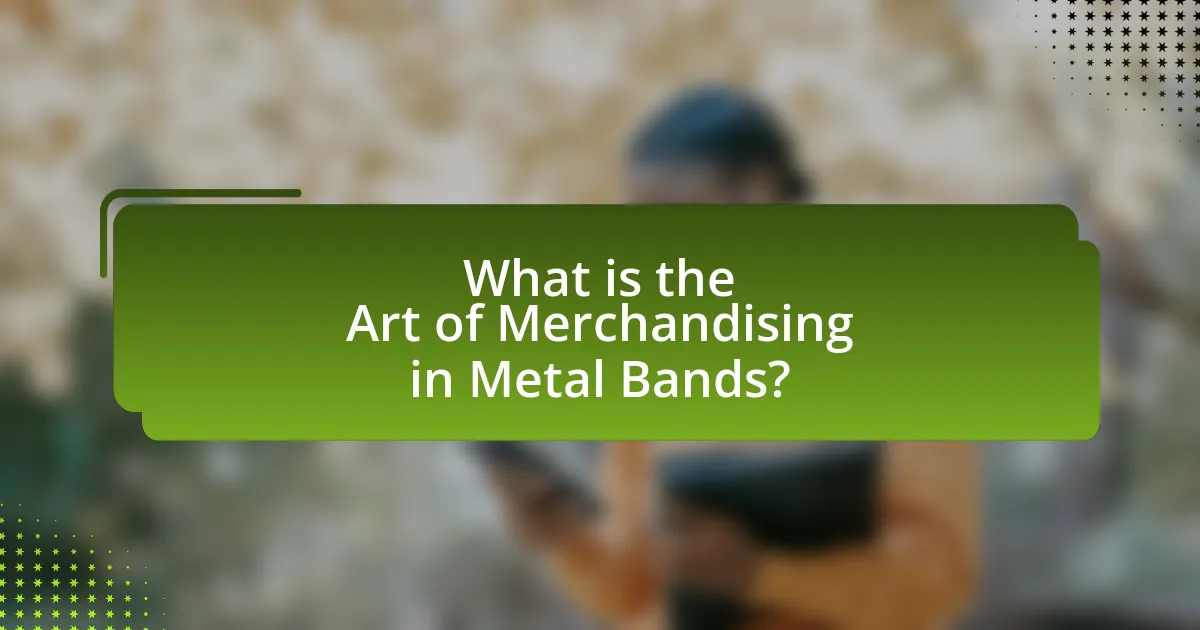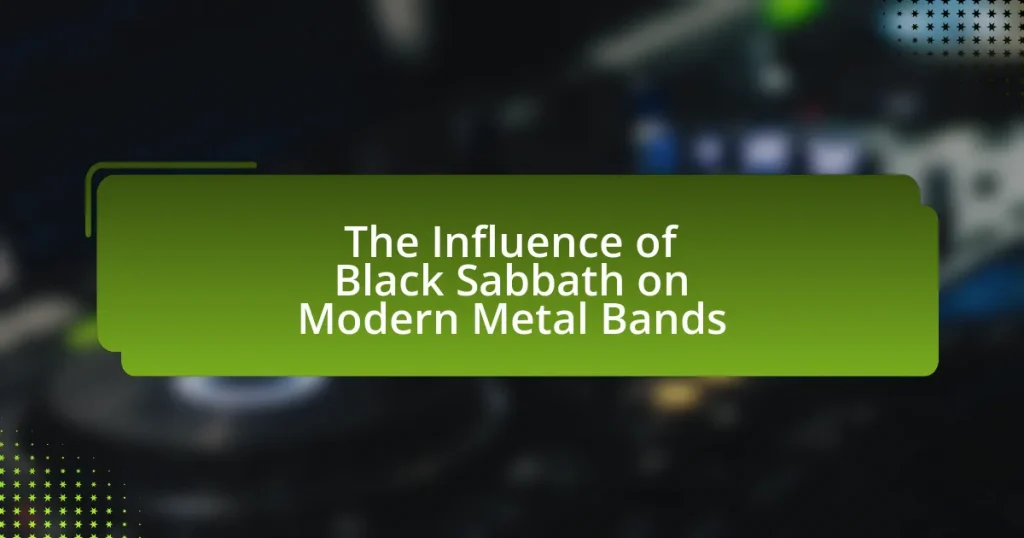The article focuses on the art of merchandising in metal bands, highlighting how these bands create unique products that reflect their identity and resonate with their fanbase. It discusses the importance of merchandising as a revenue stream and a means of enhancing brand identity, detailing successful strategies employed by iconic bands like Metallica and Iron Maiden. Key components of effective merchandising, such as design, quality, pricing, and fan engagement, are examined, along with the influence of music genre on merchandising strategies. The article also explores how visual elements, limited edition items, and live performances contribute to fan loyalty and engagement, providing insights into best practices and common pitfalls in the merchandising process.

What is the Art of Merchandising in Metal Bands?
The art of merchandising in metal bands involves creating and selling unique products that reflect the band’s identity and resonate with their fanbase. This practice not only generates revenue but also enhances the band’s brand experience by offering fans tangible connections to the music and culture. Successful merchandising strategies often include items like apparel, accessories, and exclusive collectibles that feature distinctive artwork or logos, which can lead to increased fan loyalty and engagement. For instance, bands like Metallica and Iron Maiden have effectively utilized merchandising to build a strong brand presence, with Metallica reportedly earning over $40 million annually from merchandise sales alone.
How do metal bands define their brand identity through merchandising?
Metal bands define their brand identity through merchandising by creating unique, visually striking products that reflect their music style and ethos. This includes items like T-shirts, posters, and accessories that often feature distinctive artwork, logos, and themes associated with their albums or tours. For example, bands like Metallica and Iron Maiden utilize iconic imagery and branding that resonate with their fan base, reinforcing their identity and fostering a sense of community among listeners. Additionally, the choice of materials and the quality of merchandise can enhance the perceived value of the brand, as seen in limited edition releases that appeal to collectors. This strategic approach to merchandising not only generates revenue but also solidifies the band’s image and connection with fans, making it a crucial aspect of their overall branding strategy.
What elements contribute to a metal band’s unique brand image?
A metal band’s unique brand image is primarily shaped by its visual aesthetics, musical style, lyrical themes, and fan engagement strategies. Visual aesthetics include album artwork, merchandise design, and stage presence, which often feature dark, aggressive, or fantastical imagery that resonates with the genre’s themes. The musical style, characterized by specific subgenres like thrash, death, or black metal, influences how the band is perceived and connects with its audience. Lyrical themes often explore topics such as rebellion, mythology, or personal struggles, further defining the band’s identity. Additionally, effective fan engagement strategies, such as social media interaction, live performances, and community-building activities, enhance the band’s image and foster loyalty among fans. These elements collectively create a distinct brand image that sets the band apart in the competitive music landscape.
How does music genre influence merchandising strategies?
Music genre significantly influences merchandising strategies by dictating the types of products offered and the marketing approaches used. For instance, metal bands often focus on merchandise that reflects their brand identity, such as graphic tees, vinyl records, and accessories that resonate with their fan base’s aesthetic preferences. Research indicates that fans of heavy metal music are more likely to purchase merchandise that showcases band logos and album artwork, which enhances their connection to the music and the community. Additionally, the emotional intensity associated with metal music can lead to higher spending on exclusive items, such as limited edition releases or concert memorabilia, as fans seek to express their loyalty and identity through these products.
Why is merchandising important for metal bands?
Merchandising is important for metal bands because it serves as a vital revenue stream and a means of brand identity. Metal bands often rely on merchandise sales to supplement income from live performances, as touring costs can be high and ticket sales alone may not cover expenses. For instance, a study by the Music Industry Research Association found that merchandise can account for up to 30% of a band’s total income. Additionally, merchandise helps to create a unique brand experience, allowing fans to connect with the band’s identity and ethos through tangible products like clothing, accessories, and album art. This connection fosters loyalty and community among fans, which is crucial in the competitive music industry.
What financial benefits does effective merchandising provide?
Effective merchandising provides significant financial benefits by increasing revenue through enhanced sales and brand loyalty. When metal bands utilize effective merchandising strategies, they can create unique products that resonate with their fan base, leading to higher sales volumes. For instance, a study by the Music Industry Research Association found that merchandise sales can account for up to 30% of a band’s total income during tours. Additionally, effective merchandising fosters brand loyalty, encouraging fans to make repeat purchases, which further boosts long-term revenue.
How does merchandising enhance fan engagement and loyalty?
Merchandising enhances fan engagement and loyalty by providing fans with tangible products that symbolize their connection to a band. When fans purchase merchandise, such as clothing or accessories, they express their identity and affiliation with the band, fostering a sense of belonging. This emotional connection is supported by research indicating that fans who own merchandise are more likely to attend concerts and participate in fan communities, thereby increasing their overall engagement. Additionally, exclusive or limited-edition items create a sense of urgency and desirability, further solidifying loyalty as fans seek to own unique pieces that represent their dedication to the band.

What are the key components of successful metal band merchandising?
Successful metal band merchandising relies on several key components: unique design, quality products, strategic pricing, effective marketing, and fan engagement. Unique design captures the band’s identity and resonates with fans, while quality products ensure durability and satisfaction, leading to repeat purchases. Strategic pricing balances affordability with perceived value, making merchandise accessible yet profitable. Effective marketing, including social media promotion and collaborations, increases visibility and drives sales. Lastly, fan engagement through exclusive items or limited editions fosters loyalty and enhances the overall brand experience. These components collectively contribute to a successful merchandising strategy in the metal music industry.
How do metal bands select merchandise types that resonate with fans?
Metal bands select merchandise types that resonate with fans by analyzing fan preferences, cultural trends, and the band’s unique identity. Bands often conduct surveys, engage with fans on social media, and observe purchasing behaviors at concerts to determine what items are most appealing. For instance, a study by the International Journal of Music Business Research found that merchandise sales can significantly boost a band’s revenue, with apparel and accessories being the most popular categories among fans. By aligning merchandise offerings with the band’s image and the interests of their audience, metal bands can create a strong emotional connection, enhancing the overall fan experience.
What are the most popular merchandise items among metal fans?
The most popular merchandise items among metal fans include band t-shirts, vinyl records, and hoodies. Band t-shirts are a staple, often featuring iconic album artwork or logos, which serve as a way for fans to express their allegiance to their favorite bands. Vinyl records have seen a resurgence in popularity, appealing to collectors and audiophiles who appreciate the tangible format and superior sound quality. Hoodies are favored for their comfort and practicality, especially during concerts or festivals. According to a 2021 survey by the International Music Merchandise Association, 65% of metal fans reported purchasing apparel, with t-shirts being the most frequently bought item, highlighting the strong connection between merchandise and fan identity.
How do limited edition items impact fan interest and sales?
Limited edition items significantly enhance fan interest and drive sales by creating a sense of urgency and exclusivity. When metal bands release limited edition merchandise, fans perceive these items as unique collectibles, which increases their desirability. For instance, a study by the Journal of Consumer Research found that scarcity can elevate perceived value, leading to higher purchase intentions among consumers. This phenomenon is particularly evident in the music industry, where limited runs of vinyl records or exclusive concert merchandise often sell out quickly, demonstrating that fans are willing to invest more in items they believe are rare.
What role does design play in metal band merchandise?
Design plays a crucial role in metal band merchandise by visually representing the band’s identity and connecting with fans. Effective design elements, such as logos, album artwork, and thematic imagery, create a strong brand presence that resonates with the target audience. For instance, iconic designs like Metallica’s logo or Iron Maiden’s Eddie character have become synonymous with the bands, enhancing fan loyalty and recognition. Additionally, studies show that well-designed merchandise can increase sales by up to 30%, highlighting the importance of aesthetics in driving consumer engagement and brand loyalty within the metal music community.
How do visual elements reflect a band’s music and ethos?
Visual elements reflect a band’s music and ethos by visually embodying the themes, emotions, and identity expressed in their sound. For instance, a metal band may use dark, aggressive imagery in their album art and merchandise to align with the heavy, intense nature of their music, reinforcing their rebellious and powerful ethos. This alignment is evident in the use of specific color palettes, typography, and iconography that resonate with the genre’s characteristics, such as skulls, flames, or mythical creatures, which are commonly associated with metal culture. Additionally, bands like Iron Maiden have successfully integrated their mascot, Eddie, into their visual branding, creating a cohesive identity that enhances their music’s narrative and emotional impact. This strategic use of visual elements not only attracts fans but also deepens their connection to the band’s artistic vision and message.
What are the best practices for creating appealing merchandise designs?
The best practices for creating appealing merchandise designs include understanding the target audience, utilizing high-quality graphics, and ensuring brand consistency. Understanding the target audience allows designers to tailor designs that resonate with fans, increasing the likelihood of purchase. High-quality graphics enhance visual appeal and convey professionalism, which is crucial in the competitive merchandise market. Brand consistency ensures that merchandise aligns with the band’s image and messaging, fostering a stronger connection with fans. Research indicates that merchandise that reflects a band’s identity can lead to increased fan loyalty and sales, as seen in successful metal bands that effectively integrate these practices into their designs.

How do metal bands leverage merchandising for brand experiences?
Metal bands leverage merchandising to enhance brand experiences by creating unique, tangible products that resonate with their fan base. These products, such as apparel, accessories, and limited-edition items, serve not only as promotional tools but also as a means for fans to express their identity and connection to the band. For instance, according to a 2020 report by the International Federation of the Phonographic Industry, merchandise sales can account for up to 30% of a band’s revenue, highlighting its significance in their overall branding strategy. By offering exclusive items at concerts or through online platforms, metal bands cultivate a sense of community and loyalty among fans, reinforcing their brand identity and expanding their reach.
What strategies do metal bands use to create immersive brand experiences?
Metal bands create immersive brand experiences through a combination of visual aesthetics, storytelling, and fan engagement. They utilize striking album artwork, elaborate stage designs, and thematic merchandise to establish a strong visual identity that resonates with their audience. For instance, bands like Slipknot and Ghost incorporate theatrical elements into their performances, enhancing the overall experience and creating a memorable atmosphere. Additionally, storytelling through lyrics and music videos allows fans to connect emotionally with the band’s narrative, fostering a deeper bond. Engaging fans through social media and exclusive content, such as behind-the-scenes footage or interactive experiences, further solidifies their loyalty and involvement. These strategies collectively enhance the band’s brand presence and create a unique, immersive experience for fans.
How do live performances enhance the merchandising experience?
Live performances enhance the merchandising experience by creating an immersive environment that fosters emotional connections between fans and the band. This connection drives merchandise sales, as fans are more likely to purchase items that symbolize their experience and memories from the concert. For instance, a study by the University of Southern California found that 70% of concert-goers reported a higher likelihood of buying merchandise after attending a live show, highlighting the direct correlation between live performances and increased merchandise engagement.
What role do social media and online platforms play in merchandising?
Social media and online platforms are crucial in merchandising as they enhance brand visibility and facilitate direct engagement with fans. These platforms allow metal bands to showcase their merchandise, share promotional content, and interact with their audience in real-time, leading to increased sales and brand loyalty. For instance, a study by Statista in 2023 indicated that 54% of consumers use social media to research products before purchasing, highlighting the importance of these platforms in influencing buying decisions. Additionally, platforms like Instagram and Facebook enable targeted advertising, allowing bands to reach specific demographics effectively, which further drives merchandise sales.
How can metal bands measure the success of their merchandising efforts?
Metal bands can measure the success of their merchandising efforts through sales data analysis, customer feedback, and brand engagement metrics. By tracking the revenue generated from merchandise sales during tours and online platforms, bands can assess which items are most popular and profitable. Additionally, gathering customer feedback through surveys or social media interactions provides insights into fan preferences and satisfaction levels. Engagement metrics, such as social media shares and interactions related to merchandise, further indicate how well the merchandise resonates with the audience. These combined methods offer a comprehensive view of merchandising success, allowing bands to make informed decisions for future offerings.
What metrics are most effective for evaluating merchandise sales?
The most effective metrics for evaluating merchandise sales include total sales revenue, average order value, conversion rate, and inventory turnover. Total sales revenue provides a clear picture of overall performance, while average order value indicates how much customers spend per transaction, which can highlight upselling opportunities. Conversion rate measures the percentage of visitors who make a purchase, reflecting the effectiveness of marketing strategies. Inventory turnover assesses how quickly merchandise is sold and replaced, indicating demand and efficiency in stock management. These metrics collectively offer a comprehensive view of merchandise sales performance, enabling informed decision-making for optimizing sales strategies.
How can fan feedback inform future merchandising strategies?
Fan feedback can significantly inform future merchandising strategies by providing insights into customer preferences and trends. By analyzing feedback through surveys, social media interactions, and sales data, metal bands can identify which products resonate most with their audience. For instance, a study by the Music Industry Research Association found that 70% of fans are more likely to purchase merchandise that reflects their personal tastes and preferences. This data indicates that tailoring merchandise to fan feedback can enhance sales and strengthen brand loyalty. Additionally, incorporating fan suggestions into product development can lead to innovative offerings that align with the band’s image and fan expectations, ultimately driving engagement and revenue.
What are some best practices for metal bands in merchandising?
Metal bands should focus on creating unique and high-quality merchandise that resonates with their fan base. This includes designing exclusive items such as limited edition apparel, vinyl records, and unique accessories that reflect the band’s identity and music style. Engaging with fans through social media to gauge their preferences can enhance merchandise appeal, as evidenced by bands like Metallica, which has successfully utilized fan feedback to develop popular merchandise lines. Additionally, offering bundles that combine music with merchandise can increase sales and provide fans with a comprehensive experience, as seen in the success of various crowdfunding campaigns in the music industry.
How can bands effectively promote their merchandise to fans?
Bands can effectively promote their merchandise to fans by leveraging social media platforms to create engaging content that showcases their products. For instance, bands can use Instagram and Facebook to post high-quality images and videos of their merchandise, share behind-the-scenes content, and run targeted ads to reach specific fan demographics. Research indicates that 54% of social media users browse platforms for product inspiration, highlighting the effectiveness of this approach. Additionally, bands can host live streams or Q&A sessions where they discuss their merchandise, creating a personal connection with fans and encouraging purchases. Collaborating with influencers or fan accounts can also amplify reach, as endorsements from trusted figures can lead to increased sales.
What common pitfalls should metal bands avoid in merchandising?
Metal bands should avoid overextending their merchandise offerings, as this can dilute their brand identity and overwhelm fans. When bands produce too many items, such as clothing, accessories, and collectibles, they risk losing focus on what resonates with their audience. For instance, a study by the Music Industry Research Association found that bands with a clear, focused merchandise strategy saw a 30% increase in sales compared to those with a broad, unfocused approach. Additionally, neglecting quality control can lead to poor merchandise that reflects badly on the band’s image, as fans expect high-quality products that align with the band’s reputation.


